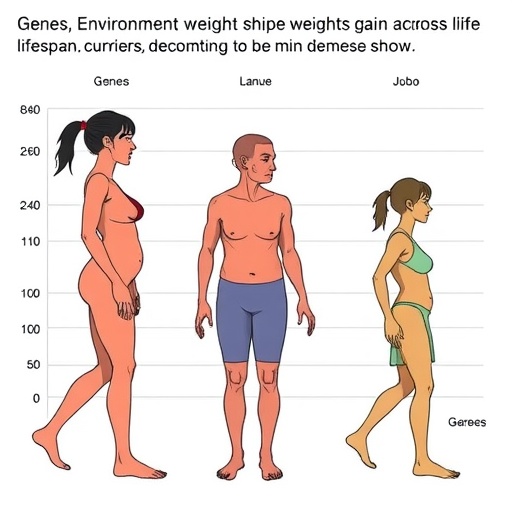In a comprehensive and groundbreaking study recently published in Nature Communications, researchers have shed light on the complex interplay between ethnicity, COVID-19 mortality, and cardiovascular disease (CVD) in the populations of England and Wales from 2020 to 2022. This extensive investigation reveals deeply rooted health disparities manifesting along ethnic lines, emphasizing how socio-demographic variables continue to influence health outcomes in pandemic times—offering a crucial lens through which policymakers, healthcare providers, and researchers alike can approach public health equity going forward.
At the core of this inquiry lies a detailed cohort analysis involving multi-ethnic populations across England and Wales over the two critical years of the COVID-19 pandemic. By meticulously integrating national mortality records with health datasets, the research team offers unprecedented granularity in discerning how individuals from various ethnic backgrounds were differentially impacted by both COVID-19 and pre-existing cardiovascular conditions. This level of detail marks a significant leap from prior studies that often treated minority populations as monoliths or lacked sufficient sample sizes for robust sub-group analysis.
One of the pivotal findings of this study concerns the disproportionate mortality rates observed among minority ethnic groups compared to the White British majority. The data unequivocally demonstrates that ethnic minorities, particularly South Asian and Black communities, experienced significantly higher COVID-19 mortality rates. These disparities remained pronounced even after adjusting for age, sex, socioeconomic deprivation, and comorbid conditions—highlighting that ethnicity itself, or factors strongly correlated with ethnicity, plays a distinct and independent role in COVID-19-related outcomes.
.adsslot_qhFSblOGKx{ width:728px !important; height:90px !important; }
@media (max-width:1199px) { .adsslot_qhFSblOGKx{ width:468px !important; height:60px !important; } }
@media (max-width:767px) { .adsslot_qhFSblOGKx{ width:320px !important; height:50px !important; } }
ADVERTISEMENT
Beyond COVID-19 mortality, the study delved into the prevalence and impact of cardiovascular diseases within these ethnic groups, recognizing CVD as a critical driver of mortality. Notably, the incidence of conditions such as ischemic heart disease and cerebrovascular disease was substantially elevated in certain ethnic populations prior to infection, compounding their vulnerability during the pandemic. This elevated baseline risk, coupled with the systemic challenges faced during the health crisis, created a ‘perfect storm’ scenario whereby ethnic minority groups were at heightened risk not just of infection but of severe clinical outcomes and death.
The researchers employed advanced statistical methodologies, including multivariable Cox proportional hazards models and competing risk analyses, to ensure that confounders and biases were rigorously accounted for. Their approach underscores the importance of sophisticated epidemiological techniques when parsing data across heterogeneous populations, enabling a more accurate attribution of risk factors and illuminating pathways towards targeted interventions. The robustness of these methods lends considerable weight to the study’s findings and the subsequent public health implications.
One emergent theme from this work is the interplay between social determinants of health and biological susceptibility. While biological factors such as genetic predispositions to certain cardiovascular conditions may partly explain some disparities, the social environment—including factors like housing density, occupational exposure, and access to healthcare—also profoundly shapes outcomes. The pandemic thus functioned as a magnifier of pre-existing inequities, revealing how structural factors entrenched by systemic marginalization can lead to starkly differentiated health profiles within the same national context.
Importantly, the temporal scope of the research, spanning the height and later phases of the pandemic, enables the identification of dynamic trends in mortality and disease burden. The study notes shifts in mortality patterns that corresponded with public health interventions such as lockdown measures, vaccination rollouts, and changes in healthcare delivery. These observations highlight how policy measures can have varying efficacy across ethnic groups, potentially mediated by differential vaccine access or hesitancy, healthcare trust, and socio-economic barriers.
The implications of these findings extend far beyond academic circles, demanding urgent attention from health authorities and governmental bodies. Tailored public health strategies that address the unique vulnerabilities of ethnic minorities are imperative. This encompasses culturally competent healthcare delivery, enhanced community engagement to improve vaccine uptake, and socio-economic policies aimed at mitigating deprivation and occupational risks. The research pushes for a paradigm shift—from one-size-fits-all interventions to nuanced, equity-driven responses that anticipate and tackle disparities proactively.
Cardiovascular disease management also emerges as a key frontier in mitigating COVID-19 mortality among ethnic minorities. The study’s data indicates that pre-existing CVD exacerbates COVID-19 severity, underscoring the necessity for improved preventative care and chronic disease management within these communities. This calls for increased screening, earlier intervention, and sustained management efforts focused on high-risk populations to prevent the convergence of multiple health crises in vulnerable groups.
Of particular note is the study’s extensive use of national-level data infrastructures, reflecting the power of integrated health information systems. The ability to link infection, hospital admission, mortality, and health record data across a multi-ethnic population provides a template for future epidemiological research not only in infectious diseases but in chronic illness management and health equity monitoring. This integrated approach offers critical lessons for other nations grappling with similar demographic complexities.
The researchers also call for further investigation into the molecular and immunological mechanisms underpinning the observed disparities. Understanding how genetic variants, immune response differences, and inflammatory processes vary among ethnic groups could unlock new avenues for personalized medical interventions and therapeutics. Such biological insights, combined with socio-environmental analyses, would yield a comprehensive understanding of ethnic health disparities.
Moreover, the study underscores the enduring legacy of historical health inequalities. Ethnic disparities in health outcomes are not novel phenomena but are rooted in decades of systemic disparities in housing, employment, education, and healthcare access. COVID-19 acted as a stark reminder and accelerator of these inequalities. Addressing such deep-rooted issues requires multidisciplinary approaches engaging social scientists, economists, clinicians, and policymakers alike.
This research invigorates public discourse around the imperative of incorporating ethnicity as a critical factor in health surveillance and response frameworks. It suggests that routine disaggregation of health data and stratified analyses by ethnic groups should become standard practice to ensure visibility and responsiveness to minority health outcomes. Only through such transparency and targeted data collection can tailored public health responses be appropriately designed and implemented.
In conclusion, the study by Pineda-Moncusí and colleagues represents a landmark contribution to our understanding of how ethnicity intersects with infectious disease dynamics and chronic health burdens in the context of one of the most challenging public health crises in modern history. It calls for renewed commitment to health equity, leveraging cutting-edge data science, clinical research, and policy innovation to prevent future pandemics from exacerbating long-standing disparities. Its message is clear: addressing ethnic health disparities is not ancillary but central to achieving resilient and fair healthcare systems.
The findings not only inform the immediate response to COVID-19 but set a precedent for integrating equity-focused research into broader health system planning and emergency preparedness. By illuminating the pathways through which ethnicity influences health outcomes, this work empowers stakeholders to design epidemiologically sound, socially conscious, and medically effective interventions—transforming how societies confront health disparities in the 21st century. Understanding and acting upon these insights is crucial as the world moves beyond the acute phase of the pandemic towards a future where pandemic threats remain an ever-present possibility.
Subject of Research: Ethnic disparities in COVID-19 mortality and cardiovascular disease in England and Wales between 2020-2022.
Article Title: Ethnic disparities in COVID-19 mortality and cardiovascular disease in England and Wales between 2020-2022.
Article References:
Pineda-Moncusí, M., Allery, F., Abbasizanjani, H. et al. Ethnic disparities in COVID-19 mortality and cardiovascular disease in England and Wales between 2020-2022. Nat Commun 16, 6059 (2025). https://doi.org/10.1038/s41467-025-59951-4
Image Credits: AI Generated
Tags: addressing health inequalities in minority populationscardiovascular disease in ethnic populationscomprehensive study on heart disease and ethnicityethnic disparities in COVID-19 mortalityimpact of socio-demographic factors on health outcomesimplications for healthcare policy and practiceintegration of mortality records and health datasetsminority ethnic groups and health disparitiesmulti-ethnic cohort analysis of COVID-19public health equity in England and WalesSouth Asian health outcomes during pandemic





